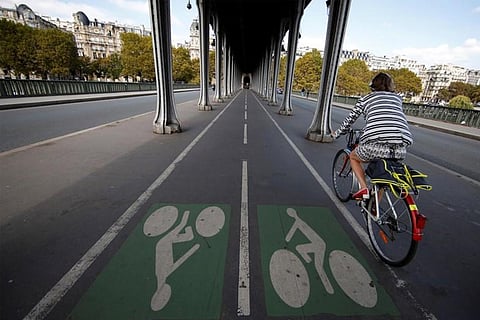

Chennai
The officers were not buying his explanation he was commuting to his job outside of Zaragoza, the northern city where he lives. “You have a car, don’t you? Why don’t you use that?” he was asked. Pasamar had to hire a lawyer to convince police the government had not banned cycling during the lockdown.
As countries seek to get their economies back on track after the devastation wrought by the coronavirus pandemic, bicycle use is being encouraged as a way to avoid unsafe crowding on trains and buses. Cycling activists from Germany to Peru are trying to use the moment to get more bike lanes, or widen existing ones, even if it’s just a temporary measure to make space for commuters on two wheels.
The transition to more bike-friendly urban environments “is necessary if we want our cities to work,” said Morton Kabell, who co-chairs the European Cyclists’ Federation. “People will be afraid of going on public transportation, but we have to get back to work someday. Few of our cities can handle more car traffic,” he said.
In addition to bike lanes separated by curbs, Kabell backs subsidising electric bicycles, which could encourage commuters who have longer or hilly journeys. The benchmarks are Copenhagen, the capital of Denmark, where half of the daily commuters are cyclists, and the Netherlands, with its vast network of bike lanes.
Still, countries around the world are catching up at different speeds. The French government asked cycling activist Pierre Serne to draw up a plan for when its lockdown ends May 11. His recommendations, including bicycle lanes separated from other vehicles at an estimated cost of 50,000 euros per km ($32,000 per mile), have been submitted to the Transportation Ministry. For now, France has said it will subsidise riders up to 50 euros (nearly $55) for repairs so the French can get their bicycles ready for post-lockdown rides.
In Berlin, the Friedrichshain-Kreuzberg council simply painted yellow lines on the some roads to take space from car lanes. This bike infrastructure builds on what is called “tactical urbanism” — lowcost changes that are technically simple and reversible, and they can make an immediate difference.
Similar initiatives are popping up elsewhere. Officials in Lima, Peru; Barcelona, Spain; and Milan, Italy, are speeding up plans to expand bike paths or take space from cars or current parking sites. In Bogota, where bicycles are used mostly by Colombia’s blue-collar workers, Mayor Claudia Lopez has urged everybody returning to work this week to cycle instead of using public transportation, which is now operating at 35% of capacity.
With many US nonessential businesses closed, there is little point now in cycling that isn’t recreational. But cities like Oakland, San Francisco and New York are closing some streets to traffic to allow room for runners and cyclists. Pedro Diaz, a member of Pedalibre, a Madrid cycling club, sees this as a once-in-a-lifetime opportunity to take over space from cars and resist giving it back when the pandemic ends. “If we wait for proper infrastructure for bicycle lanes, we’ll need a municipal plan, which will take at least four years to be designed and get approved,” Diaz said.
“This way, it’s just a matter of putting a fence and stopping cars from using a lane. Then it will be a fait accompli.” Beyond infrastructure, cycling advocates say many minds must still be changed, noting that many officials have called for prioritising the use of private vehicles in the lockdown.
Visit news.dtnext.in to explore our interactive epaper!
Download the DT Next app for more exciting features!
Click here for iOS
Click here for Android